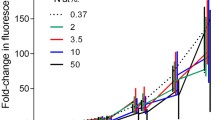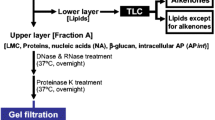Abstract
Using three species of marine brown algae, we describe a stable isotope labeling technique to quantify: (1) in situ rates of phlorotannin synthesis, (2) phlorotannin polymerization or aging, and (3) the related allocation of carbon resources to secondary metabolism. In our field and laboratory assays, Lobophora variegata (Bahamas), Sargassum pteropleuron (Bahamas), and Fucus distichus (California, USA) assimilated various quantities of 13C, but all allocated ≤ 1% of the assimilated carbon to the production of phlorotannins. We quantified rates of phlorotannin synthesis both as micrograms of compound produced per gram of tissue per unit of time and as micrograms of compound produced per gram of C assimilated per unit of time. Rates of synthesis, normalized to account for differences in potential photosynthetic rates, are comparable to previously reported rates of phlorotannin accumulation. The aging of phlorotannins from low- (<30 kDa) to high- (>30 kDa) molecular-size polymers was observed in S. pteropleuron within a 28-hr period. Our results indicate that, using this labeling technique, it is possible to make precise measurements of allelochemical metabolism and resource allocation, which are useful both in critically evaluating the assumptions made by ecological models of plant chemistry and in estimating the partial metabolic cost of specific secondary metabolites.
Similar content being viewed by others
REFERENCES
Arnold, T. M., Tanner, C. E., and Hatch, W. I. 1995. Phenotypic variation in polyphenolic content of the tropical brown alga Lobophora variegata as a function of nitrogen availability. Mar. Ecol. Prog. Ser. 123:177–183.
Baldwin, I. T., and Ohnmeiss, T. E. 1994. Coordination of photosynthetic and alkaloidal responses to damage in uninducible and inducible Nicotina sylvestris. Ecology 75:1003–1014.
Baldwin, I. T., Karb, M. J., and Ohnmeiss, T. E. 1994. Allocation of 15N from nitrate to nicotine: Production and turnover of a damage-induced mobile defense. Ecology 75:1703–1713.
Bazzaz, F. A., Chiariello, P. D., Coley, P. D., and Pitelka, L. F. 1987. Allocating resources to reproduction and defense. BioScience 37:58–67.
Bernays, E. A., Cooper-Driver, G., and Bilgener, M. 1989. Herbivores and plant tannins. Adv. Ecol. Res. 19:263–302.
Boettcher, A. A., and Targett, N. M. 1993. Role of polyphenolic molecular size in reduction of assimilation efficiency in Xiphister mucosus. Ecology 74:891–903.
Boutton, T. W. 1991. Stable carbon isotope ratios of natural materials: I. Sample preparation and mass spectrometric analysis, pp. 155–171, in D. C. Colman and B. Fry (eds.). Carbon Isotope Techniques. Academic Press, San Diego, California.
Briggs, M. A., and Schultz, J. C. 1990. Chemical defense production in Lotus corniculatus L. II. Trade-offs among growth, reproduction, and defense. Oecologia 83:32–37.
Bryant, J. P., Chapin, F. S., Reichardt, P. B., and Clausen, T. P. 1987. Response of winter chemical defense in Alaska paper birch and green alder to manipulation of plant carbon/nutrient balance. Oecologia 72:510–514.
Burbott, A. J., and Loomis, W. D. 1969. Evidence for metabolic turnover of monoterpenes in peppermint. Plant Physiol. 44:173–179.
Chew, F. S., and Rodman, J. E. 1979. Plant Resources for chemical defense, pp. 271–300, in G. A. Rosenthal and D. H. Janzen (eds.). Herbivores: Their interactions with secondary metabolites. Academic Press. New York.
Coley, P. D. 1986. Costs and benefits of defense by tannins in a neotropical tree. Oecologia 70:238–241.
Coley, P. D., Bryant, J. P., and Chapin III, F. S. 1985. Resource availability and plant anti-herbivore defense. Science 230:895–899.
Croteau, R., Burbott, A. J., and Loomis, W. D. 1972. Biosynthesis of mono-and sesui-terpenes in peppermint from glucose-14C and 14CO2. Phytochemistry 11:2459–2467.
Denton, A., Chapman, A. R. O., and Markham, J. 1990. Size specific concentrations of phlorotannins (anti-herbivore compounds) in three species of Fucus. Mar. Ecol. Prog. Ser. 65:103–104.
Fagerstrom, T. 1989. Anti-herbivore chemical defense in plants: A note on the concept of cost. Am. Nat. 133:281–287.
Feeny, P. P. 1976. Plant apparency and chemical defense. Recent Adv. Phytochem. 10:1–40.
Geiselman, J. A. 1980. Ecology of chemical defenses of algae against the herbivorous snail Littorina littorea in the New England rocky intertidal community. PhD thesis. Woods Hole Oceanographic Institution, Woods Hole, Massachusetts.
Gershenzon, J., Murtagh, G. J., and Croteau, R. 1993. Absence of rapid terpene turnover in several species of terpene accumulating plants. Oecologia 96:583–592.
Han, K., and Lincoln, D. E. 1994. The evolution of carbon allocation to plant secondary metabolites: A genetic analysis of cost in Diplacus aurantiacus. Evolution 48(5):1550–1563.
Hatch, W. I., Tanner, C. E., Butler, N. M., and O'Brien, E. P. 1993. A Micro-Folin-Denis Method for the Rapid Quantification of Phenolic Compounds in Marine Plants and Animals. International Society of Chemical Ecology. Tampa, Florida (abstract).
Hay, M. E., and Fenical, W. 1988. Marine plant-herbivore interactions: The ecology of chemical defense. Annu. Rev. Syst. Ecol. 19:111–145.
Herms, D. A., and Mattson, W. J. 1992. The dilemma of plants: To grow or defend. Q. Rev. Biol. 67:283–335.
Ilvessalo, H., and Tuomi, J. 1989. Nutrient availability and accumulation of phenolic compounds in the brown algae Fucus vesiculosus. Mar. Biol. 101:115–119.
Lerdau, M., and Gershenzon, J. 1997. Allocation theory and chemical defense, pp. 265–277, in F. A. Bazzaz and J. Grace (eds.). Plant Resource Allocation. Academic Press, San Diego, California.
Lerdau, M., Litvak, M., and Monson, R. 1994. Plant chemical defense: monoterpenes and the growth-differentiation balance hypothesis. Trends Ecol. Evol. 9(2):58.
Littler, M. M., and Arnold, K. E. 1984. Primary productivity of marine macroalgal functional-form groups from southwestern North America. J. Phycol. 18:307–311.
Mihaliak, C. A., Gershenzon, J., and Crouteau, R. 1991. Lack of rapid monoterpene turnover in rooted plants: Implications for theories of plant chemical defense. Oecologica 87:373–376.
Mole, S., Butler, L. G., Hagerman, A. E., and Waterman, P. G. 1989. Ecological tannin assays: A critique. Oecologia 78:93–96.
Norris, J. N., and Fenical, W. 1982. Chemical defenses in tropical marine algae, pp. 417–431, in K. Rutzler and I. G. Macintyre (eds.). The Atlantic Barrier Reef Ecosystem at Carrie Bow Cay, Belize, Smithsonian Contribution to the Marine Sciences. Smithsonian Institute Press, Washington, DC.
Peckol, P., Krane, J. M., and Yates, J. L. 1996. Interactive effects of inducible defense and resource availability on phlorotannins in the North Atlantic brown alga Fucus vesiculosus. Mar. Ecol. Prog. Ser. 138:209–217.
Pederson, A. 1984. Studies on phenol content and heavy metal uptake in fucoids. Hydrobiologia 116/117:498–504.
Pfister, C. A. 1992. Costs of reproduction in the intertidal kelp: Patterns of allocation and life history consequences. Ecology 73:1586–1596.
Ragan, M. A., and Glombitza, K. W. 1986. Phlorotannins, brown algal polyphenolics, pp. 129–241, in F. E. Round and D. J. Chapman (eds.). Progress in Phycological Research, Volume 4. Biopress, Bristol, England.
Ragan, M. A., and Jensen, A. 1978. Quantitative studies on brown algal phenols. II. Seasonal variation in polyphenolic content of Ascophyllum nodosum (L.) Le Jol. And Fucus vesiculosus (L.). J. Exp. Mar. Biol. Ecol. 34:245–258.
Reichardt, P. B., Chapin, F. S., III, Bryant, J. P., Mattes, B. R., and Clausen, T. P. 1991. Carbon/nutrient balance as a predictor of plant defense in Alaskan balsam poplar: Potential importance of metabolite turnover. Oecologia 82:217–226.
Rhoades, D. F., and Cates, R. G. 1976. Toward a general theory of plant antiherbivore chemistry. Recent Adv. Phytochem. 10:168–213.
Rosenthal, G. A., and Janzen, D. H. 1979. Herbivores, their interaction with secondary plant metabolites. Academic Press, New York.
Sharp, J. H. 1973. A quick and simple measurement for total inorganic carbon in seawater pp. 143–144, in Research on the Marine Food Chain. Progress report to the U.S. Atomic Energy Commission. University of Califgrnia, San Diego Institute of Marine Resources.
Steinberg, P. D. 1984. Algal chemical defense against herbivores: Allocation of phenolic compounds in the kelp Alaria marginata. Science 223:405–407.
Steinberg, P. D. 1992a. Geographical variation in brown algal polyphenolics and other secondary metabolites: Comparison between temerate Australasia and North America. Oecologia 78:373–382.
Steinberg, P. D. 1992b. Geographical variation in the interaction between marine herbivores and secondary metabolites, pp. 51–92, in V. J. Paul (ed.). Ecological Roles of Marine Natural Products. Cornell University Press, Ithaca, New York.
Steinberg, P. D. 1995. Seasonal variation in the relationship between growth rate and phlorotannin production in the kelp Eklonia radiata. Oecologia 102:169–173.
Targett, N. M., Coen, L. D., Boettcher, A. A., and Tanner, C. E. 1992. Biogeographic comparisons of marine algal polyphenolics: Evidence against a latitudinal trend. Oecologicau 89:464–470.
Targett, N. M., Boettcher, A. A., Targett, T. E., and Vrolijk, N. H. 1995. Tropical marine herbivore assimilation of phenolic-rich plants. Oecologia 103:170–179.
Tugwell, S., and Branch, G. M. 1989. Differential polyphenolic distribution among tissues in the kelps Ecklonia maxima, Laminaria pallida, and Macrocystis angustifolia in relation to plant-defense theory. J. Exp. Mar. Biol. Ecol. 129:219–230.
Tuomi, J. 1992. Toward integration of plant defense theories. Trends Ecol. Evol. 7:365–367.
Tuomi, J., Ilvessalo, H., Miemela, P., Siren, S., and Jormalainen, V. 1989. With-in plant variation in phenolic content and toughness of the brown alga Fucus vesiculosus. L. Bot. Mar. 32:505–509.
Van Aalstyne, K. L. 1988. Grazing increases polyphenolic defenses in the intertidal brown alga Fucus distichus. Ecology 69:655–663.
Van Alstyne, K. L. 1995. Comparison of three methods for quantifying brown algal polyphenolic compounds. J. Chem. Ecol. 21:45–58.
Waterman, P. G., and Mole, S. 1994. Analysis of Phenolic Plant Metabolites. Blackwell Scientific, Oxford, p. 238.
Wu, Y., and Gretz, M. R. 1993. Stable isotope labeling method for studies of saccharide metabolism in Agardhiella subulata. Hydrobiologia 260/261:595–600.
Yates, J. L., and Peckol, P. 1993. Effects of nutrient availability and herbivory on polyphenolics in the seaweed Fucus vesiculosus. Ecology 74:1757–1766.
Zangerl, A. R., and Bazzaz, F. A. 1992. Theory and pattern in plant defense allocation, pp. 363–391, in R. S. Fritz and E. L. Simms (eds.). Plant Resistance to Herbivores and Pathogens. Chicago, University of Chicago Press.
Author information
Authors and Affiliations
Rights and permissions
About this article
Cite this article
Arnold, T.M., Targett, N.M. Quantifying in Situ Rates of Phlorotannin Synthesis and Polymerization in Marine Brown Algae. J Chem Ecol 24, 577–595 (1998). https://doi.org/10.1023/A:1022373121596
Issue Date:
DOI: https://doi.org/10.1023/A:1022373121596




